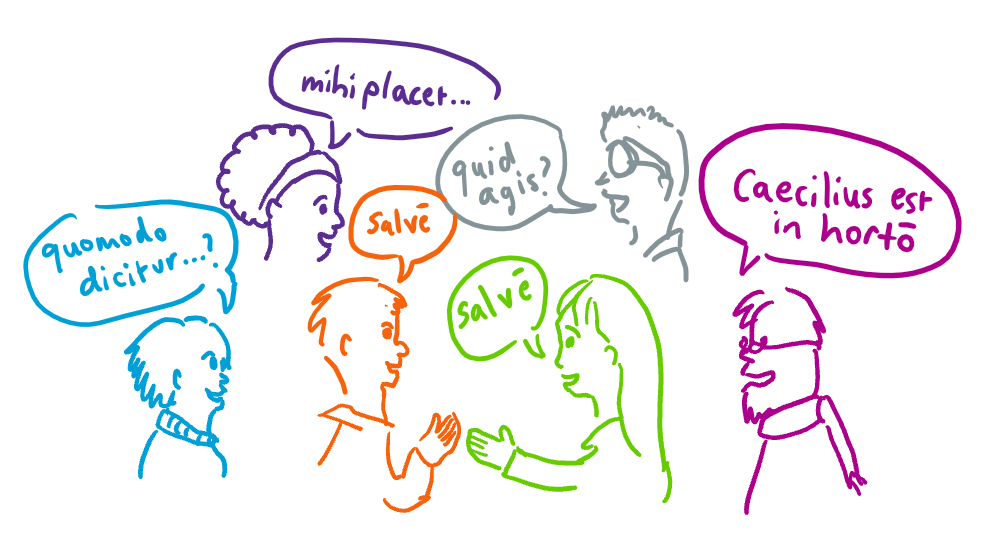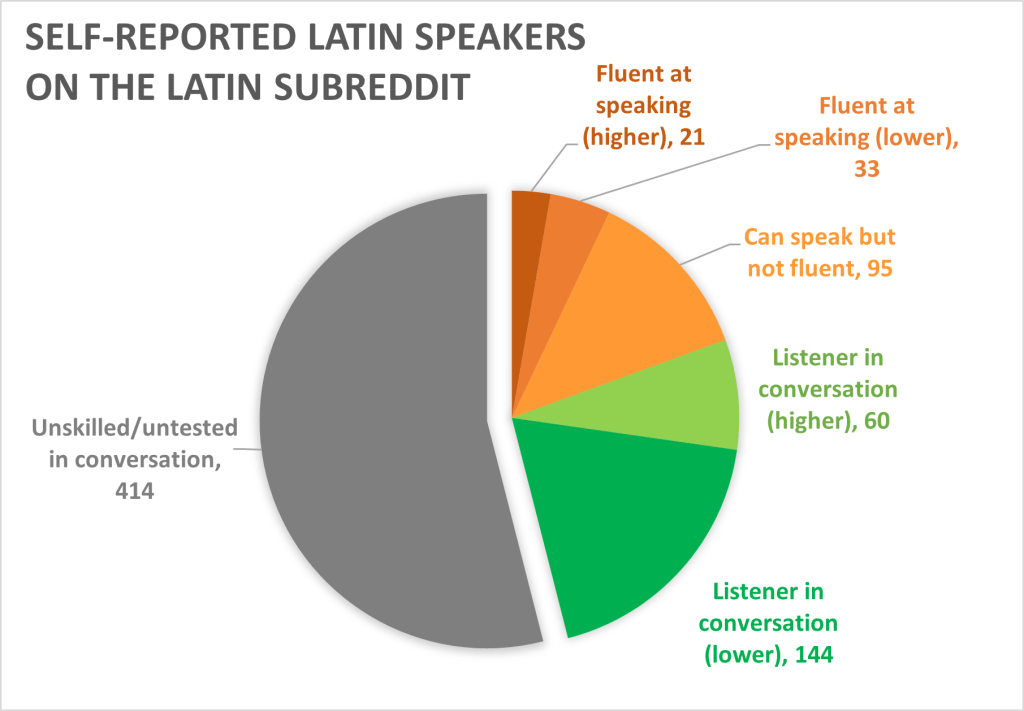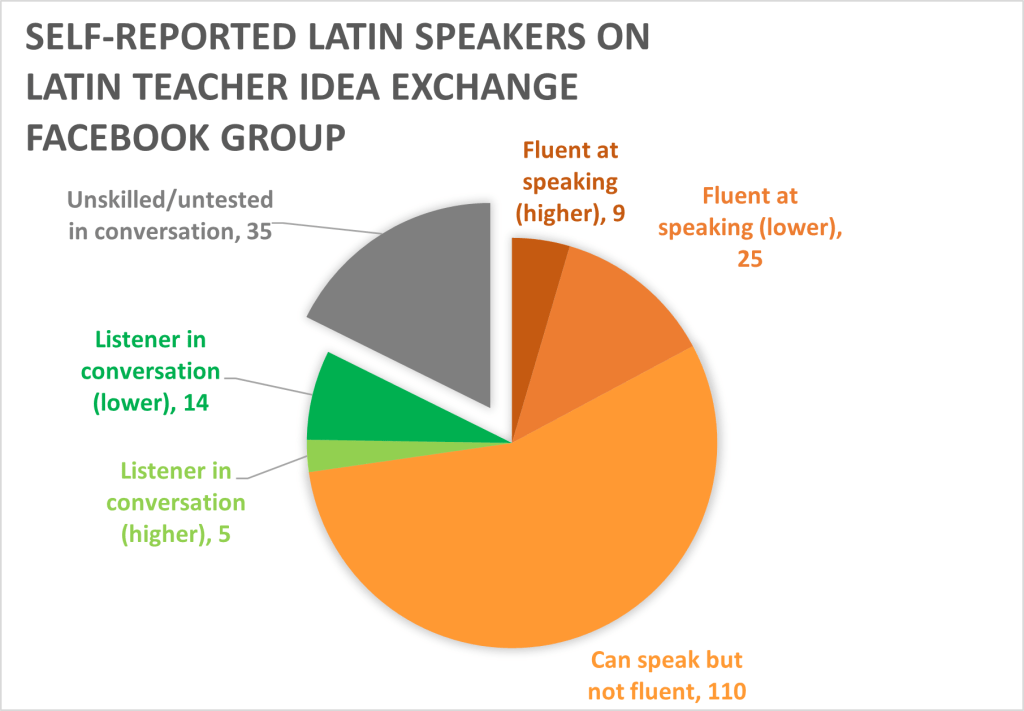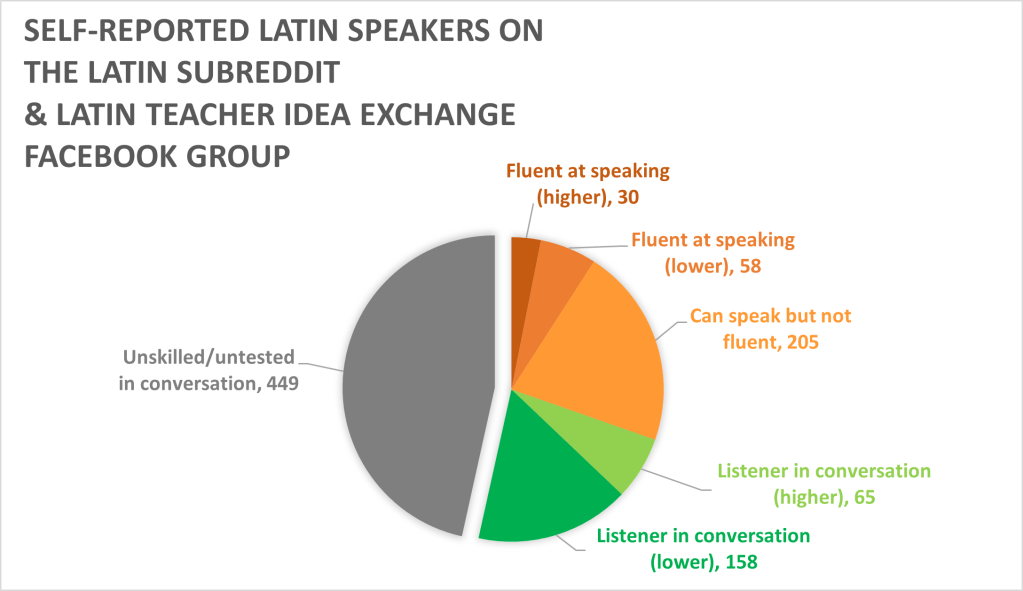This article was originally written for the Iris publication of the Classics Association Victoria. The print version will come out in March 2022 at the annual conference. I will also be presenting a talk on incorporating spoken Latin in classrooms.

Thanks to the internet age, we now have ways of teaching and learning Latin that were previously inconceivable.
As teachers and lovers of Latin, we ought to recognise these new opportunities. There is a burgeoning community of living Latin speakers in our times, and we have a duty to assess how this new technologically-connected world can help us improve our teaching and learning of Latin.
The rise of the internet has sparked two major developments promoting living Latin:
Firstly, the internet has allowed niche hobbyists separated by geography to gather around their shared interests and create larger, united communities. For the Latin community, this has meant that speakers from across the globe have been able to create a more coherent speaking community in which expertise and fluency in spoken Latin is fostered, improving the abilities of all members at different skill levels. This has enabled more Latin content creators to emerge, creating better spoken Latin materials for upskilling members of the community, setting in motion a positive feedback loop that is revitalising the language.
Secondly, the internet has allowed new language teaching methods to be shared, and new materials for implementing said methods. Latin novellas, audiobooks, podcasts, and high-quality Latin video content are now available on-demand from anywhere in the globe. The self-publishing nature of the internet has allowed Latin speakers to bypass the traditional gatekeepers of mainstream publishing. A vibrant and growing body of Latin learning materials has rapidly emerged within the last 10 years.
Part 1: The living Latin revival
We are witnesses to a burgeoning revival of spoken Latin around the globe.
Living Latin spreading with the internet
The internet has allowed the living Latin movement to overcome geographical boundaries. People had been meeting in person at Latin-speaking conferences, conventicula, in Europe and the US for many decades already (the first SALVI conferences were in 1997-1998, for instance).[1] But with the rise of video streaming sites like YouTube, many recordings of these Latin-speaking events have been posted online. A niche conference held in a particular time and place becomes a permanent record of spoken Latin, viewable from anywhere. One can find a YouTube playlist containing 70+ hours of advanced-level spoken Latin, many videos of which were recorded from spoken Latin events.
Live conversations now take place regularly throughout the week among Latin-speaking communities whose members are geographically separated. There are several Discord servers through which speakers meet and host regular weekly voice chats.[2] Several Latin speaking groups also meet to talk over Zoom on regularly scheduled weekly times, now running four times per week.
Of particular interest to school teachers is the rise of YouTube channels posting engaging spoken Latin videos. Notable content creators include the following:
Luke Ranieri regularly posts spoken Latin videos on his channel ScorpioMartianus. Among these is a series of videos designed specifically to be used as comprehensible input for newcomers in Latin, his Lingua Latina Comprehensibilis series. The meaning of the Latin in many of his videos is supported by his use of props and gestures, as well as carefully chosen stock footage.
Irene Regini, who runs the channel Satura Lanx, produces many spoken Latin videos explaining topics of grammar, word choice, and ancient literature, as well as vlogs on aspects of her daily life. She is a Latin teacher based in Italy with many years of experience in teaching Latin through spoken input. Her videos are an asset to the community.
My channel, Found in Antiquity, focuses on creating subtitled comprehensible input in Latin that is very beginner-friendly. The Minecraftium series introduces Latin words in the context of the game of Minecraft, and features a continuous narrative that is partly shaped by audience participation in the comments section. I also have other comprehensible input series such as Your Body in Latin (focusing on medical Latin) as well as Latin videos inspired by pop-culture fandoms such as Pokemon and Harry Potter.
Jesse Craft, on his channel Divus Magister Craft, produces video adaptations of stories from history and mythology. Comprehension is aided by the Latin and English subtitles that come with all his videos. The visuals also help immensely – Jesse Craft creates breathtakingly detailed animations for his Latin content by recording the visuals from a heavily-modded version of Minecraft.
Daniel Pettersson on Latinitium runs a Latin website as well as a YouTube channel. He produces many high-quality spoken Latin videos of intermediate difficulty on a wide range of classical and contemporary topics, and has recently released a Latin reading app (Legentibus) with synchronised text and audio.
There are many other channels including numerous Latin vloggers and podcasters who publish their thoughts in conversational Latin, such as Musa Pedestris, Legio XIII, Andreas Alcor, Alexius Cosanus[3], and others.
Could anyone even 10 years ago have found as much spoken Latin in video format as what can be found on even one of these channels?
Many of us have long been aware of the Finnish Latin news broadcast, Nuntii Latini, which released week 5-minute radio segments that ran from 1989-2019. The Nuntii Latini were posted on the internet with transcriptions and glossaries, all still accessible today, and enjoyed a viewership of 40,000 in 2019.[4] This broadcast was nearly cancelled in 2017 and finally discontinued in 2019, when the creators of the long-running program retired, citing that there were now far more Latin resources in the world than when the program first started. The news is still being regularly reported in Latin by several other programs, the German-based Lateinischer Monatsrückblick, the Vatican-based Nuntii Latini, and the Washington-based Nuntii Latini. The internet has allowed all of these Latin news broadcasts from disparate places in the world (Finland, Germany, Italy, and the US) to gain international readership among the broader Latin community.
How big is the Latin speaking community?
There are several ways to estimate the size of the living Latin community.
One way would be to count the number of attendees at Latin speaking events held worldwide. In 2007, a single meeting in Naples organized by the Academy Vivarium Novum had over 300 Latin speakers present.[5] The Conventiculum Lexintonense in 2014 had 85 participants.[6] There are several other Latin speaking conventions such as the Conventiculum Dickinsoniense, the Rusticationes and the Bidua organised by SALVI. The Circuli Latini site lists 17 active Latin speaking groups throughout Europe and North America, and one in Hong Kong. The number and size of these meetings would suggest that there are at least a few hundred active Latin speakers worldwide.
Thirteen years ago, in 2009, a Census Latinus was conducted by Western Washington University through mass emailing and advertising on two Latin journals.[7] It hadn’t been advertised on social media and didn’t reach all Latin speaking groups before the data collection period was over, but 440 individuals responded to the survey. Out of these, 289 participants reported that they had skill in speaking Latin, and 68 said they had spoken Latin for over 10 years.[8] (As a side note, 2 of the Latin speakers were reported as being 2 years old in 2009, indicating that some Latin users were speaking with their toddlers in Latin.)[9] The numbers from the 2009 Census, while not showing the full picture of all Latin speakers, indicate there were at least a few hundred speakers of Latin.
In January 2021, I created a quick poll on the Latin Subreddit counting the number of self-reported Latin speakers in the Reddit community. The poll was active for 3 days, and 767 users responded to it. Out of these, 149 reported that they had at least some Latin speaking experience, and 54 self-identified as ‘fluent speakers’. (See Fig. 1 and 2. Note, however, that ‘fluent’ is a subjective term which does not necessarily mean that a person has achieved native-like proficiency in the language; the data from especially the anonymous reddit poll needs to be taken with caution as it is likely for users to overstate their competence.)
[Fig. 1] The poll (users selected only one option):
| Text as it appeared in the poll | Abbreviated for graphs |
| I consider myself a fluent Latin speaker. I am comfortable entering any spoken Latin conversation on any topic. | Fluent at speaking (higher) |
| I consider myself a fluent Latin speaker. I’m comfortable talking about most topics. | Fluent at speaking (lower) |
| I don’t consider myself fluent, but I have spoken and effectively communicated in Latin conversation at least once. | Can speak but not fluent |
| I prefer to listen in on conversations, but I comprehend them well, understanding most of the words. | Listener in conversation (higher) |
| I prefer to listen in on conversations, and I miss a lot of words, but get the general gist of the topic. | Listener in conversation (lower) |
| I’m currently at a speaking/listening level lower than all the above statements or untested in conversation. | Unskilled/untested in conversation |
[Fig. 2]

I conducted the same poll in the Latin Teacher Idea Exchange facebook group (asking members not to vote on both the reddit poll and the facebook poll) and after 2 days it had 198 respondents, of whom 144 reported they had Latin speaking experience, and 34 labelled themselves as ‘fluent speakers’. (See Fig. 3)
[Fig. 3]

These rough polls did not reach the full breadth of Latin speaking communities – both were conducted in English in mostly-Anglophone Latin groups, whereas there is a very significant if not larger population of Latin speakers in non-Anglophone Europe. Nevertheless, assuming there were no duplicate answers between the polls, at least 293 English-speaking Latinists have reported that they have used Latin in spoken communication. It seems reasonable to suggest that there are at least a few hundred Latinists with speaking experience, and perhaps double this number would be found if one were to poll non-English Latin speakers too.
[Fig. 4]

However, active speakers are just one part of the living Latin community. The listeners are the other, much larger, component, and are just as vital to the growth of the living Latin movement.
The viewership numbers for videos spoken entirely in Latin rank in the thousands. The YouTube channel ScorpioMartianus, which produces content exclusively in Latin and Ancient Greek, currently has 81.6K subscribers – although this subscriber count reflects inactive accounts as well as recent viewers. The view count on recent videos is more representative of a channel’s active audience. As per January 2022, the ten most recent Latin videos on ScorpioMartianus (excluding videos which were songs on dubbed movie clips) had an average of 9.1K views. On my channel, Found in Antiquity, which is smaller and newer than ScorpioMartianus, spoken Latin videos often attract about a thousand views. It appears from these numbers that the audience of spoken Latin content is in the thousands, and that is only counting those who use YouTube.
If it’s accurate to say that the Finnish Nuntii Latini enjoyed a viewership of 40,000 in 2019,[10] it would be reasonable to suggest that the Latin listening audience could number even in the tens of thousands.
The internet acts like a lever: A relatively small number of highly productive Latin speakers can produce video and audio content which reaches thousands of viewers and increases the language competency of the whole community. This creates a positive feedback loop that makes it more likely for new content creators to emerge.[11] As new creators bring different ideas and skills into creating Latin audio and video content, they further promote the language and make it more accessible to a broader audience.
One thing is clear: an international Latin speaking community exists, and it is making high quality Latin content.
The next question is how we can make use of this community in our Latin teaching.
Part 2: The spread of new teaching methods and learning materials.
When I started teaching Latin, the resources I had were the published textbook materials, anything I made myself, and any resources made by previous Latin teacher(s) to match with the current textbook.
It’s now no longer just ourselves and the textbook.
Because of the connectivity of the internet, we now have access to the creative efforts of Latin teachers and enthusiasts from around the globe. My main points in this section are:
- We don’t need to be highly proficient speakers to show students spoken Latin videos.
- We don’t need to be novelists to give students Latin novellas to read.
- We don’t need to have met an active Latin teacher in person to get practical advice from them on how to use spoken Latin in the classroom.
All these things and more are facilitated by the rise of sharing and self-publishing in the internet age.
Firstly, it cannot be overstated how much of a difference comprehensible spoken Latin makes to language acquisition. When Latin is understood at the speed of speech, learners can process as much as 60 words per minute. Translation from textbooks is much slower than this – in my experience, students translate Latin into written English at a rate of about 5-10 words per minute. Using spoken Latin in place of written translation could mean as much as a 1200% increase in the amount of Latin encountered. The sheer volume of content which can be delivered in audio-visual format vastly overshadows the amount of content that is provided by translation tasks in textbooks.
The idea of teaching Latin through listening comprehension is not new – the Direct Method in the early 20th century, the Nature Method in the mid 20th century, and Krashen’s Comprehensible Input Hypothesis of the 1970s and 1980s are not new. What is new is that a Latin teacher can now immediately show students a video of comprehensible spoken Latin, without having already become a fluent Latin speaker themselves. A teacher doesn’t need to be the only source of spoken Latin in the classroom. The voices of Latinists from all over the world can be instantly brought into the classroom to serve as spoken comprehensible input.
Secondly, the internet has given us an entirely new genre of learning materials: the Latin novella, with sheltered vocabulary but unsheltered grammar. These novellas, written by Latin teachers around the world but especially in North America, contain compelling narratives that are so easy to read that they can be read for pleasure even at very early stages in language learning. Novellas in this genre are often 2,000 words or longer, but recycle a small vocabulary of high-frequency words, so that the reader spends less time looking up words and more time understanding the flow of what they are reading. Some schools have gone ‘untextbooked’ and teach the Latin language completely through the massive input provided by novellas, with grammar being taught as a ‘pop-up’ affair after students start noticing patterns in the language. But novellas can be used flexibly within Latin classes – a teacher can set up a ‘sustained silent reading’ as a component of lessons, which would increase natural language acquisition even if the rest of the course remained unchanged in nature.
The novella genre has emerged very rapidly, thanks to the self-publishing channels that now exist on the internet. The first Latin novella, Iter Icari, was published in 2014. As of January 2022, there are now at least 115 novellas – here is the most complete list of current novellas. If each novella represents about 2,000 words of content, that would mean over 230,000 words of highly entertaining easy Latin prose has been written and published in less than eight years. A genre that was previously non-existent is now so large that a student probably can’t exhaust all the Latin novellas in the time it takes to graduate from high school.
The novella genre exists because of the rise of print-on-demand, self-publishing sites which allow authors to bypass traditional publishers. Latin teachers could freely experiment with a new medium of teaching Latin – extensive reading – and share this development with other Latin teachers. Without being novelists ourselves, we can benefit immensely from the development of this new and exciting genre.
Thirdly, there are now more ways than ever to get advice from Latin teachers who have gone before us and tried new ways of implementing spoken Latin and input-based methodologies in classrooms.
The Latin Teacher Lab, founded by Justin Slocum-Bailey, releases YouTube videos giving practical advice and example activities on how to incorporate compelling comprehensible input in Latin classes without already being a fluent Latin speaker.
Facebook groups such as Teaching Latin for Acquisition and Latin Best Practices: The Next Generation in Comprehensible Input are excellent places to find ideas and resources for increasing the comprehensible input offered in Latin classrooms. One can often find valuable resources such as tiered readings of classical texts, and descriptions of low-prep but highly effective input-based activities.[12] But these are not static pages. They are communities of Latin teachers, and you can ask the people who have tried an activity how it went and what they had done to modify it.
The playing field has changed since I learned Latin in school in the late 2000s. Thanks to the internet, switching to input-based and spoken Latin practices in the classroom is easier than it ever has been. The Latin community itself has been growing and increasing in productive skills. Content creators on YouTube are reaching audiences of thousands with videos spoken entirely in the ancient language. Over a hundred Latin novellas have been published in just eight years. Latin itself is being revitalised as a communicative language. With toddlers and very young children learning spoken Latin, even the idea that Latin is not natively spoken might need to be revised within our lifetime. Our duty in the present is to seize these opportunities to create more joyful and effective learning experiences for our students.
[1] https://latin.org/wordpress/salvi-programs/
[2] These servers include ‘Latin’, ‘LLPSI’, and ‘LukeRanieri.com’, as well as other Discord servers for smaller friendship groups.
[3] Alessio Schiano (Alexius Cosanus, one of the Latin vloggers mentioned above) and his wife Gemma Lawless teach through Latin at a bilingual Latin-English school, Weston Classical School, in Tenessee, USA. Latin is used as a language of instruction across multiple subjects, such as maths, science, and history, including among young primary students. They have been posting dozens of videos of very young students responding to Latin questions in Latin with ease and joy.
[4] https://www.rte.ie/news/world/2019/0624/1057298-latin/
[5] Eduardo Engelsing, “Census Latinus 2009: Goals, Data Collected, Importance, Perspectives,” Classical World 110, no. 3 (2017): 406
[6] https://mcl.as.uky.edu/dead-language-resurrected-uk
[7] Eduardo Engelsing, “Census Latinus 2009: Goals, Data Collected, Importance, Perspectives,” Classical World 110, no. 3 (2017): 406
[8] Ibid, 418-419
[9] Ibid, 406
[10] https://www.rte.ie/news/world/2019/0624/1057298-latin/
[11] I would not have started creating Latin YouTube content if I hadn’t been watching ScorpioMartianus for at least a year. That channel was both a source of inspiration and had a very positive impact on my Latin fluency. I hope that my channel will do the same for other content creators.
[12] A tiered reading is where the student is presented with a simpler Latin version of a piece of classical text, and reads gradually more complex versions before being presented with the original text. It allows students to understand difficult Latin through simpler Latin, to stay in the target language, and has a side effect of making students read about three times as much Latin as they would have otherwise been exposed to, compared to if they were just made to struggle with a dictionary through translating the one original text.

3 responses to “The internet brings spoken Latin back into classrooms”
[…] thousands or possibly tens of thousands of active listeners consuming spoken Latin content. (See this post for how I estimated these […]
Has this been promulgated to the Grex Latine Loquentium (not speakers’ but users’) on the internet?
I did not know that salvé was Latin. I remember using it during one of my trips across the pond.